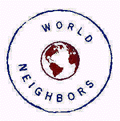![]()
![]()
 Now that the harvest has been destroyed, the
greatest problem is to find sources of food.
Now that the harvest has been destroyed, the
greatest problem is to find sources of food.
 Problems of sanitation are rising rapidly in
the shelters and river water.
Problems of sanitation are rising rapidly in
the shelters and river water.
 Many homes and
families have been shattered. People now must begin to piece their lives back together.
Many homes and
families have been shattered. People now must begin to piece their lives back together.
Now is the time when the most help is needed, in terms of time and money. There will be no more deaths from drowning in raging rivers or mudslides. Now begins the slow starvation, and diseases that spread in the unsanitary and crowded conditions. Now is the most dangerous time, for millions could be lost if the country spirals into despair and chaos.
![]()
There are several organizations working on these difficult problems.
 |
CARE is carefully assessing the needs of the people and providing health supplies accordingly. They are providing clean water, basic sanitation facilities, soap, blankets and plastic sheeting. Hand tools for cleanup work and farming are also being distributed. |
 |
World Neighbors has been a leader of post emergency relief. The next harvest will be in two years, and emergency relief was gone within a month. With this dilemma at heart, World Neighbors immediately began to research plants that grow in mud, and produce every 30-60 days. World Neighbors is also supplying communities with farm tools. In this situation providing tools is providing self-sufficiency and from self-sufficiency springs survival. |
 |
UNICEF is working hard to organize the people and help them piece their lives back together. They have organized a teachers union, which will send it’s members into shelters to resume informal classes, since the countries’ schools are closed. They also started a woman’s network, which works to prevent illness and provide the best possible nutrition under famine/emergency conditions. |
Rebuilding Conclusion Bibliography
![]()